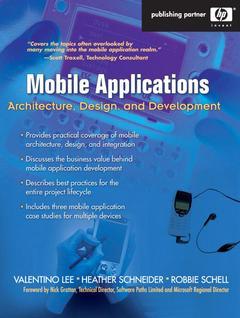Mobile applications : architecture, design and development Architecture, Design, and Development: Architecture, Design, and Development
Langue : Anglais
Auteurs : Lee Valentino, Schneider Heather, Schell Robbie

Provides technology-independent principles and practices that no mobile application developer should be without.
- Technology independent: goes beyond mobile application development by providing best practices for managing mobile applications.
- Includes a new technology to host web pages on the Pocket PC developed by the authors.
- Spending on worldwide wireless and mobile network infrastructure will rise by $10.7 billion between 2002 and 2007.
Foreword by Nick Grattan. Preface. 1. Introduction.
What Is Mobility?
Developing Mobile Applications.
Summary. 2. Business Context.
Who Is Going Mobile?
What Do People Want to Do?
Why Mobilize Your Enterprise?
Summary. 3. Mobile Application Architectures.
Client-Server.
Client.
Server.
Connection Types.
Synchronization.
Interesting Architectural Patterns.
Good Architectural Design Tenets.
Summary. 4. Mobile Infrastructure.
Mobile Device Types.
Mobile Device Components.
Connection Methods.
Summary. 5. Mobile Client User Interface.
User Interface.
Application Content.
User Experience.
Best Practices for Developing a User Interface.
Summary. 6. Mobile Client Applications.
Thin Client.
Fat Client.
Web Page Hosting.
Best Practices.
Summary. 7. Client-Server Data Transfer.
HTTP and HTML.
WAP and WML.
Synchronization Software.
RDA and Merge Replication.
SOAP and Web Services.
Message Queues.
TCP/IP.
Summary. 8. Mobilizing Existing Application Architectures.
Evolution of Enterprise Architectures.
Anatomy of an Enterprise Web Architecture.
Considerations When Mobilizing Existing Applications.
Summary. 9. Security.
Mobilized Enterprise Web Architectures.
User-to-Mobile Client Security Issues.
Mobile Client Security Issues.
Client-Server Communications Security Issues.
Existing Web Architectures and Back-End Systems Security Issues.
Summary. 10. Mobile Application Development Management.
Project Management.
Requirements.
Design.
Code Development and Integration.
Integration and System Testing.
Deployment and Release Management.
Re-Evaluation and Reiteration.
Operations and Maintenance.
Summary. 11. Mobile Museum Case Study.
Use Cases.
Architecture.
Client Detailed Design.
Server Detailed Design.
Mobilizing the Existing Application.
Discussion.
Extensions.
Summary. 12. Mobile Biologist Case Study.
Use Cases.
Architecture.
Pocket PC Client Detailed Design.
Tablet PC Client Detailed Design.
Server Detailed Design.
Discussion.
Extensions.

Mobile DevicesTools and Technologies 105,47 €
Summary. 13. Mobile Zoo Case Study.
Use Cases.
Architecture.
Client Detailed Design.
Server Detailed Design.
Discussion.
Summary. Appendices. A. Further Reading. B. Pocket Web Host Design. Index.
Date de parution : 04-2004
Ouvrage de 352 p.
17.6x23.2 cm
© 2024 LAVOISIER S.A.S.
Ces ouvrages sont susceptibles de vous intéresser

Mobile DevicesTools and Technologies 105,47 €


